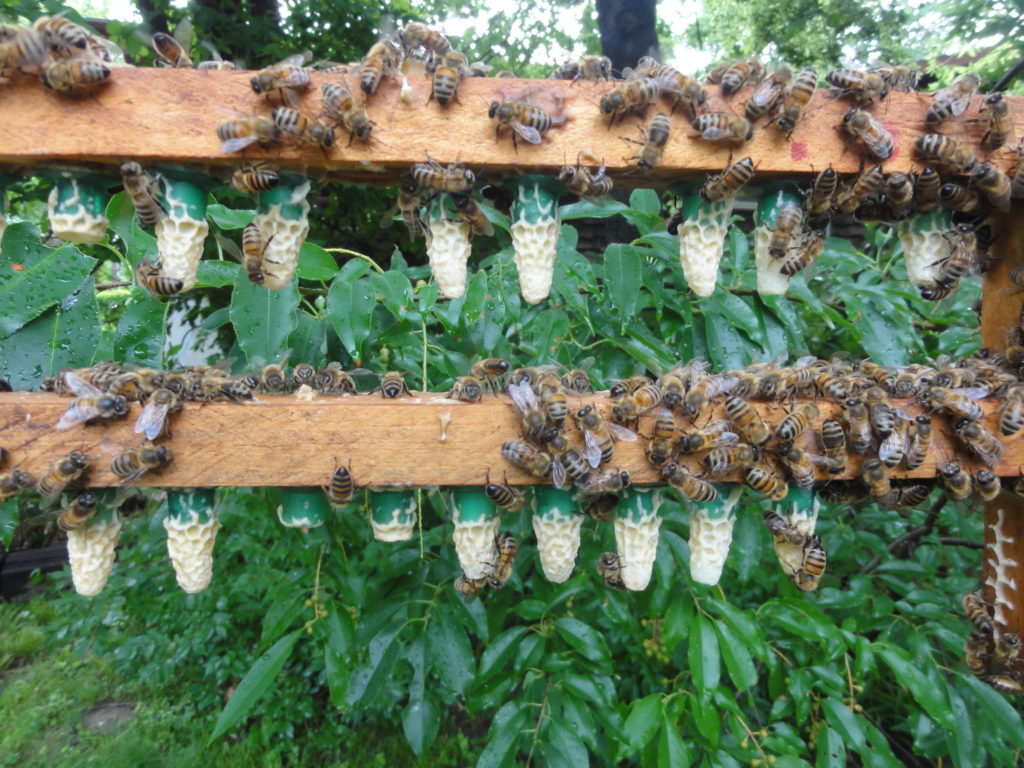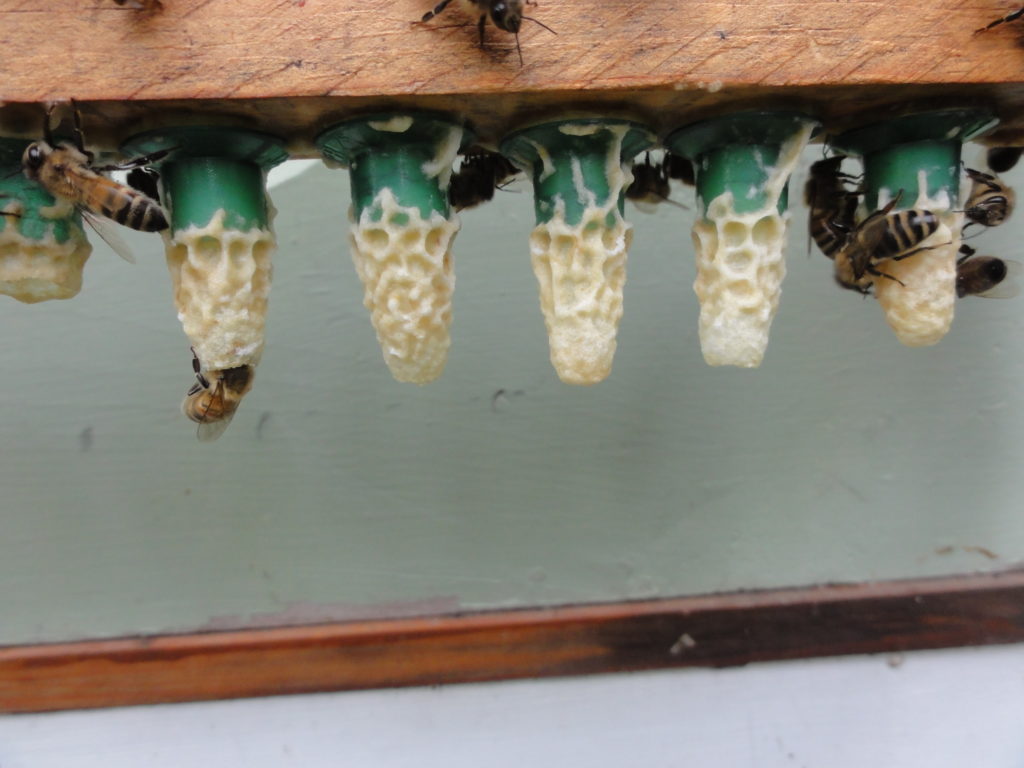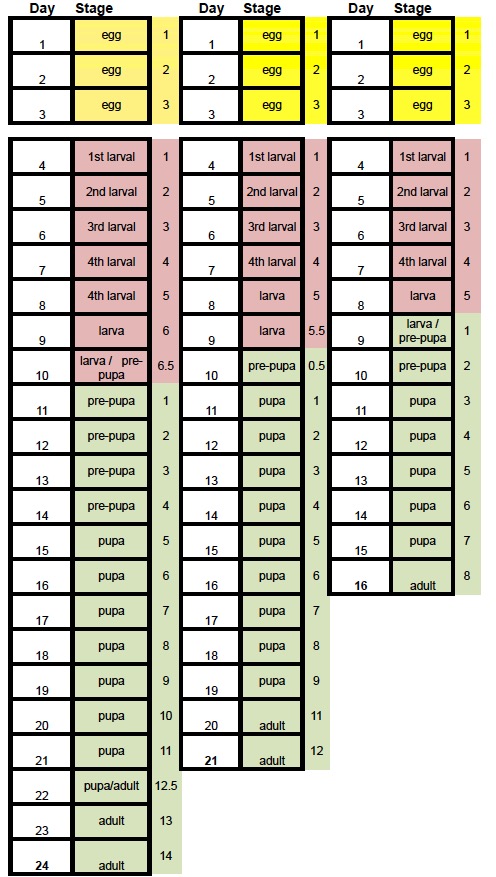
Many new beekeepers are interested in queens and eventually they want to learn how to rear their own.
I’ve listed here beekeeping equipment, equipment that I recommend for queen rearing, and some graphs for learning bee biology (egg, larva, pupa, adult) development stages. It’s essential that anyone learning about queen rearing understand the development stages of the honey bee to understand colony growth and life cycle of each caste. The egg stage lasts about 3 days. The development rates vary between queen, worker, and drone. Queen and worker bees are female, and develop from a fertilized egg. Drones develop from an unfertilized egg, and take the longest to develop.
Additional documents are provided for educational and personal use. Best wishes in your queen rearing.


Queen Rearing Supplies – Dadant.com
Beekeeping Supplies – Local from Beekeepers.com

University of Arkansas – Queen Rearing Brochure “Raising Quality Queens”
Manage Bees for increase. As the hive’s keeper, you are the manager and will have to make crucial decisions regarding the colony’s future.
Controlled Queen Rearing to Raise European Honey Bee (EHB) Queens
In June of 2005, I went to Meade, NE for a Queen Rearing Workshop, taught by Dr. Marla Spivak and Gary S. Reuter. This page represents a list of notes and a table. I raised queens in the Fall of 2005 and during 2006 with great fun and success as well as some failure(s).
There are three critical essentials to raising 1 or 100 queens
- Rearing – a queen larva needs to receive a large amount of quality feed.
- Selecting – queens ONLY from colonies with desirable traits.
Mating – improve the odds that reared queens will mate with drones from hives of desirable traits.
Controlled Queen rearing has 3 parts to the operation
Preparation – getting the cell-raising colony in the right condition to raise the queens.
Cell raising – raising the cells you want.
Completion – making nuclei, installing the cells and re-uniting the colony.
Drone Raising
Queen Rearing
Specialty of beekeeping.
In the foot-steps of Langstroth, Quinby, A.I. Root, and Doolittle.
What do we know about the production of queens?
Scientific fundamentals must be observed by anyone attempting to raise queens.
Queens are raised only from fertilized eggs [eggs that produce female bees],
- The development is 16 days +/- a few hours.
- Young larvae must be well nourished.
- A good population of young bees is needed to feed and care for the young larvae and for temperature.
Natural rearing conditions.
- Swarm.
- Emergency queen when a queenless colony has and eggs or larvae.
- Replacement of old or injured queen, or other reason – the bees will try to replace the old queen with a supersedure queen.
Methods vary:
Most common method used by commercial queen producers today is the Doolittle Method.
This method will be explained in Applied Queen Rearing.
INTRODUCTION TO APPLIED QUEEN REARING
Why queens should be reared?
The inherited and physical qualities of a queen are transmitted to the colony. The characteristics that we like to see are produced by superior queens by breeding these characteristics into stock. When one finds superior queens, every attempt should be made to propagate that stock. This is something all beekeepers can do to improve their own stock.
Other reasons would be to have a few on hand for replacement of old or failing queens or even queenless hives.
Queens raised from superior stock even by the hobbyist can be better than the stock sold.
Or raise your own queens just for the experience of it.
Or you might want to replace all of your queen each year by raising new queens to replace all your old queens and requeen each fall rather than in the spring.
Also, natural queen cells produced under the swarming impulse can be cut carefully from the comb and then used to raise more queens. If the stock is good, you can have no finer queens that those produced under the swarming impulse.
Doolittle Method of Raising Queens
Grafting procedure:
Prepare a grafting bar with cell cups.
made of wax –but plastic is becoming quite popular with commercial producers of queens.
Selecting the right larva becomes the next task for the person doing the grafting.
Grafting is usually more successful if the cell cups are primed with royal jelly and the new larva is placed on a pool of royal jelly.
“Dry” grafting is placing the larvae into a cell cup with only the royal jelly picked up with the larvae from its own cell.
Cell cups need to be warm and clean before placing larvae in them.
The location of the grafting room is important.
Good light is necessary as are the right temperature and moisture conditions.
Careful consideration of the right temperature, light, and moisture conditions will improve grafting result.
Once larva have been transferred into the queen cell cups, the bars are covered with a moist cloth and kept warm until they are given to a cell building colony.
As soon as a frame of 30 to 50 cells are grafted, it is immediately inserted into the cell builder.
Young nurse bees will visit the cell almost immediately and if accepted will start feeding the young larva.
Practice will increase speed and skill in grafting
Time is critical in raising queens.
The sooner a larvae can be grafted and provided with royal jelly and over a longer period of time that food is continued, the larger and better developed will be the resulting queen.
When raising queens there is no such thing as a vacation or rain day off.
A calendar is kept to chart the progress of each graft.
If a mistake is made in removing cells from a cell building hive, emerging queens will hatch and cut down cells of other queens and fight among themselves until only one survives.
All the work and effort to raise a number of good queens goes down the drain.
As a result every operation is scheduled exactly so that queen larvae is grafted on certain days, frames with cells are removed on certain days, and nuc’s are prepared for taking queen cells on certain days.
To check your understanding of this concept, lets assume that we graft for queen cells on June 1.
- What is the age of the larva being grafted? ______
- When should the larvae be capped into a fully developed queen cell? _______ day of the month.
- When should the queen cell be moved from the cell building hive? ______ day of the month.
- When should the new queen emerge from her cell? ______ day of the month.
- The answers are (24 – 48 hours old)
- The answer is by the 5th of June.
- The answer is by the 11th of June.
- The answer is on the 12th of June. Why? Because the larva was already 4-5 days old when it was grafted.
Handling queen cells
Queen cells are fragile.
They should never be shaken.
They must be protected from cold chills.
Chilled cells one day before the queen emerges usually result in queens born without fully developed wing.
On the other hand, they should not be exposed to high temperatures such as that found in the cab of a truck during mid summer.
The normal surrounding temperature of developing queen cells in a hive is near 92 degrees F.
If you are using the grafting method to produce queen cells, the following procedure should be used.
The queen cell bar must be handled gently.
The bees on the cell bar need to be brushed off carefully. Never shake.
Queen cells can be removed from the wooden bar.
- Do not grasp the queen cell between your fingers.
Always hold the queen cell by its base.
Queen cells removed in a towel and covered over for protection.
Queen cells can lay on their sides for a short period of time without damage.
A queen cell needs to be placed into a queenless nuc or hive as soon as possible before a queen emerges from her cell.
Commercial beekeepers often have a device for holding queen cells in the normal down position and a carrier to keep them warm.
For any extended period of time (several hours), a queen-cubator with some water works well.
The cells are placed into the warmer and carried about in the nuc yard until they are all installed into the nucs. I have transported queen cells in Styrofoam cups before.
Getting Queen mating nuc’s ready:
Every queen to be produced must have her own hive. Commercial breeders may use a full deep hive body divided into four sections with special frames designed to fit the sections of the hive. Others use a single mating nuc of 3, 4, or 5 frames.
Each nuc is made up with a comb of honey if available and a feeder for syrup to feed the nuc. In addition an ideal nuc would also include a two frames of bees and some brood. It is important that enough bees be placed in the nuc to keep the cluster large enough to cover any brood placed in the nuc. A frame of new foundation could also be added.
Nuc’s must be attended to more often than full size hives.
As the queen begins to lay eggs, the nuc will quickly become crowded with little or no space for egg laying, honey storage, or pollen storage. If queens are not sold and the cycle of raising queens continued, the management of nucs requires attention to details such as moving the nuc into a larger size hive with more frames. Otherwise, your newly raised queens will swarm or abscond (leave) the nuc. The smaller the size of the nuc box, the greater the need to visit and check a queens progress.
Harvesting Queens
Queen should be laying before harvesting. Eggs should be placed uniformly at the bottom of the cells. It is best to watch the development of these eggs to make sure they are worker eggs rather than drone eggs.
Tested Queens vs Untested Queens
Untested: means that we do not know what her daughters are going to look like.
Queens sold as ‘Breeder queens’ on the other hand, have been observed to be 1) laying uniform patterns of brood, 2) the daughters seem to have been bred true to the race of the bee, 3) the queen producers is satisfied that the queen will produce young queens from her eggs that will have the characteristics similar to their mother.
Queen Cages
Some preparation is necessary. Decide on type of holding cage for the queen must be made.
Benton three hole cage. -usually have 6 to 10 attendant bees.
Newer methods – reduction in the weight of the queen cage. Development of the battery box to ship,
The California cage is made of wood like the benton cage. -does not have attendant bees.
The EZ-BZ plastic cage. It is also a single compartment with a tube for queen cage candy on one end.
Bees can approach the queen from all sides because this cage allows direct contact from all sides except the candy end of the cage. Very popular among queen breeders because of its light weight, and labor saving value. It will also fits better between top bars even in a ten frame hive.
Sending queen in the mail:

